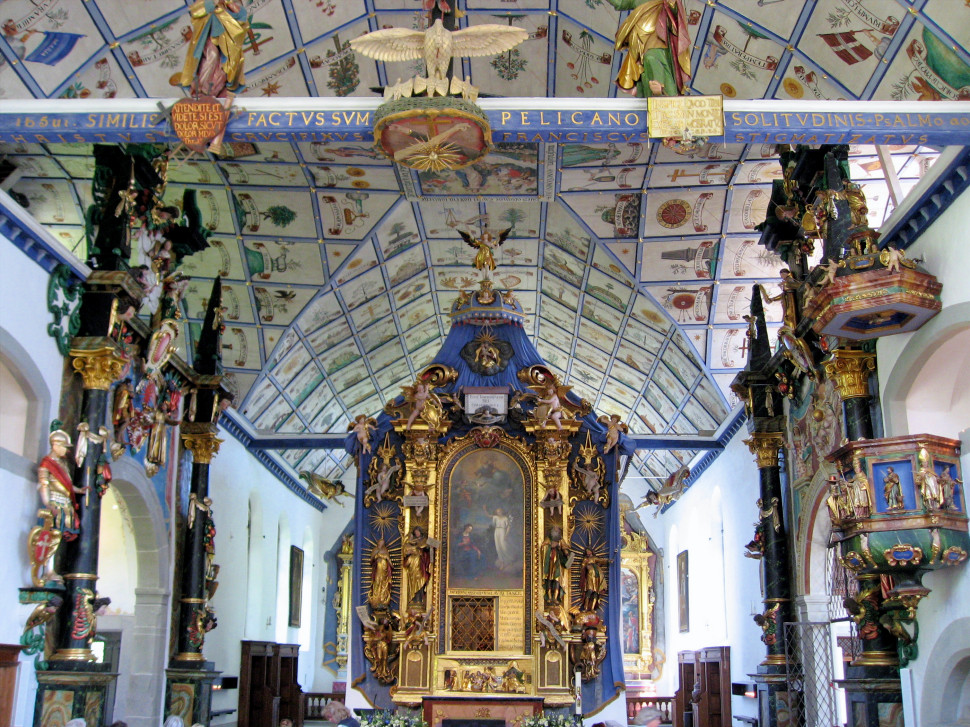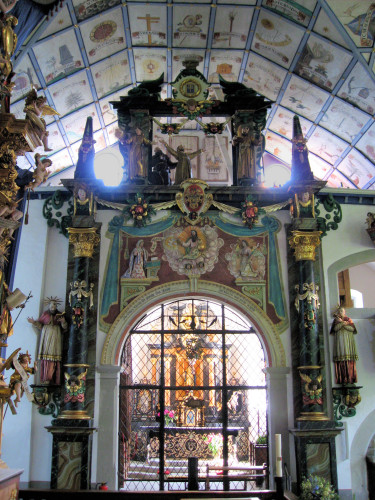Pilgrimage Chapel of Our Lady in Hergiswald
The Way of St. James leads to the Hergiswald wooden bridge. From there, the so-called "Prügelweg" leads up to the pilgrimage chapel of Our Lady in Hergiswald. Since 2009, 20 pink steles symbolising the mysteries of the rosary have been set up along the path and it is now also called the Rosary Path.
Initially, Hergiswald was not a Marian place of grace, but the pilgrimage originated from the secluded hermitage of a forest brother. In 1489, Johann Wagner from Riedlingen on the Danube settled here after living for 13 years as a Carthusian in the monastery of Ittingen on the Thur. The man wanted to lead a consecrated life in the wilderness and wasteland of the mountains, following the example of Brother Klaus, who had died two years earlier. "Two stone's throw" below today's church, the hermit is said to have lived in a kind of cave, protected by an overhanging rock. Only on Sundays and holidays did he descend to Kriens and Lucerne, where he attended mass and collected alms. Noble city nobles, above all the patrician von Wyl family, who owned the woodland, became aware of the hermit and had a simple prayer house with an altar built for him between 1501 and 1504 - the first place of worship in Hergiswald. Soon the place was visited by more and more people. When the forest brother Hans Wagner died in 1516, he was buried in the chapel in accordance with his wishes. Even years later, a bright glow is said to have risen from the hermit's grave. At the beginning of the 17th century, when pilgrimage experienced a further upswing, the old hermit chapel became too small for the onslaught of the many visitors. A new "Capell" of Our Lady in Hergiswald, donated by the von Wyl family, was consecrated in 1621. The silver image of the "Patrona Lucernae" gave additional impetus to the cult of Mary in Hergiswald. The driving force behind the further expansion of the chapel into today's pilgrimage church was the Lucerne patrician and Capuchin Ludwig von Wyl (1594-1663). In 1645 he wrote to the Lucerne Council that the Mother of God herself had instructed him at night to build a "Santa Casa" in Hergiswald: a true-to-scale replica of the House of Nazareth, the original of which, according to legend, had been miraculously brought by angels via Dalmatia to Loretto in Italy in 1291, when the Crusaders had to leave Palestine for good.)
The interior impresses with its late Baroque richness and the completely painted wooden coffered ceiling. The Lucerne painter Kaspar Meglinger (1595 - ca. 1670) created a pictorial programme with 324 panels. They are symbols and emblems largely taken from the Lauretan Litany, in praise of the Queen of Heaven and "Patrona Lucernae″.

There is an angel window at the high altar. It belongs to the "Santa Casa" behind it. There you can read: House modelled on that of Loretto, in which the Blessed Virgin Mary was conceived without original sin. Miraculously born. Nurtured for three years. Greeted by the angel Gabriel. Conceived by the Holy Spirit. The Word became flesh and dwelt among us.
On the altar wall you can see the image of the Annunciation. The angel Gabriel came to Mary in Nazareth and gave her the message that she would give birth to a child who would be the Son of God. The Lauretan tradition, however, begins with the birth of Mary. This is depicted in the relief near the original altar table.
In the "Loretto chapel″ built into the choir, donated by the French King Louis XIV, there is a pilgrimage image of a Black Madonna.
If there are still any questions about how the house of Mary of Nazareth came to Loretto, this will be answered on a picture in front of the Loretto Chapel.
Four angels carry the house here straight across Lake Lucerne. On the left you can see Lucerne with the footbridge to the Hofkirche, on the right the church of Hergiswald.


Side chapels
In a niche in the wall inside the church is the final resting place of Johann Wagner, the founder of Hergiswald.